Acer V7-482PG-9884 Review: Everything You Need
by Jarred Walton on August 24, 2013 12:00 AM ESTAcer V7-482PG General Performance
We’ll start with the usual selection of system benchmarks to show how the V7 handles everyday tasks. I don’t have a full set of results for some things, but let me just start with some general OS numbers. The V7 boots reasonably quickly – 23 seconds from power on – and it resumes from hibernate faster – around 15 seconds. Shutdown/hibernate times are typically 11-13 seconds, but unless you need to make sure the system is off before walking away/stowing it in a bag, or if you’re rebooting, I don’t find the time to shut off/hibernate to be particularly important. The boot times are definitely one area where Windows 8 has greatly improved over previous versions of the OS.
Moving on, before we get to the graphs I want to provide a quick overview of our comparison points. As usual, you can find all of the benchmark results for the V7 in Mobile Bench, along with previously tested laptops, so you can always make your own comparisons. Our selection of laptops this time is a bit more varied, as the V7 is both an Ultrabook as well as a potential gaming laptop. From the Ultrabook side of things, this is actually our first full review of a Haswell Ultrabook, so we have to return to Ivy Bridge for most of these comparisons. I’ll include the numbers that we have from the Acer S7-392 preview, but it’s not in all the charts; I’ll also include the Acer R7, Clevo W550EU, HP Spectre XT TouchSmart, and Toshiba KIRAbook. From the gaming side, we’ll include the MSI GE40, MSI GX60, MSI GT70, and the Razer Blade 14; all of these are higher-end gaming notebooks that don’t necessarily compete directly with the V7, but it’s sometimes useful to see what you give up – or in some cases don’t give up – in performance.
| Overview of Comparison Laptops | ||||||
| Laptop | CPU | GPU | Storage | RAM | LCD | Battery |
| Acer R7-571-6858 | Intel Core i5-3317U | HD4000 | 500GB HDD + 24GB SSD | 1x4GB + 1x2GB | 15.6” 1080p Glossy AHVA Touchscreen | 4-cell 54Wh |
| Acer S7-392-9890 (Preview) | Intel Core i7-4500U | HD4400 | 2x128GB RAID 0 SSDs | 2x4GB | 13.3” 1080p Glossy IPS Touchscreen | 4-cell 46Wh |
| Acer V7-482PG-9884 | Intel Core i7-4500U | GT750M DDR3 / HD4400 | 1TB HDD + 24GB SSD | 1x4GB + 1x8GB | 14” 1080p Glossy AHVA Touchscreen | 4-cell 54Wh |
| Clevo W550EU (Mythlogic) | Intel Core i5-3340M | HD4000 | 256GB SSD | 2x4GB | 15.6” 1080p Matte IPS | 6-cell 62-Wh |
| HP Spectre XT TouchSmart | Intel core i7-3517U | HD4000 | 500GB HDD + 32GB SSD | 2x4GB | 15.6” 1080p Glossy IPS Touchscreen | 4-cell 48Wh |
| MSI GE40 | Intel Core i7-4702MQ | HD4600 / GTX760M | 128GB SSD + 750GB HDD | 1x8GB | 14” 1600x900 Matte TN | 6-cell 65Wh |
| MSI GT70 Dragon | Intel Core i7-4700MQ | HD4600 / GTX780M | 128GB SSD + 750GB HDD | 4x8GB | 17.3” 1080p Matte TN | 9-cell 87Wh |
| MSI GX60 | AMD A10-5750 | HD8650G / HD7970M | 750GB HDD | 1x8GB | 15.6” 1080p Matte TN | 9-cell 87Wh |
| Razer Blade 14 | Intel Core i7-4702HQ | HD4600 / GTX765M | 256GB SSD | 2x4GB | 14” 1600x900 Matte TN | 6-cell 70Wh |
| Toshiba KIRAbook | Intel Core i7-3537U | HD4000 | 256GB SSD | 2x4GB | 13.3” 2560x1440 Glossy IPS Touchscreen | 4-cell 52Wh |
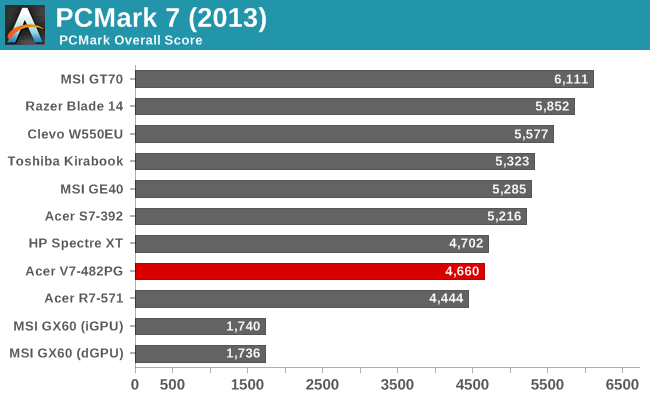
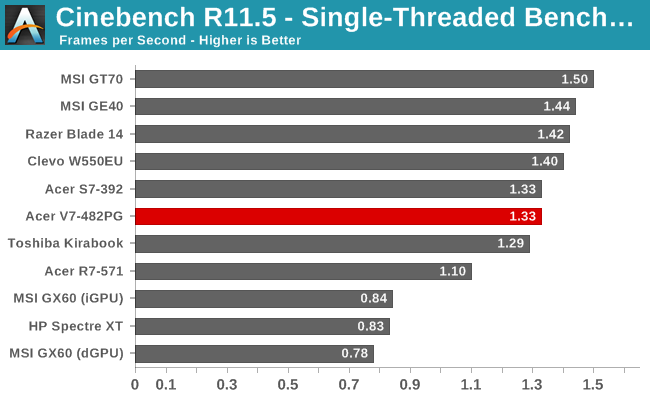
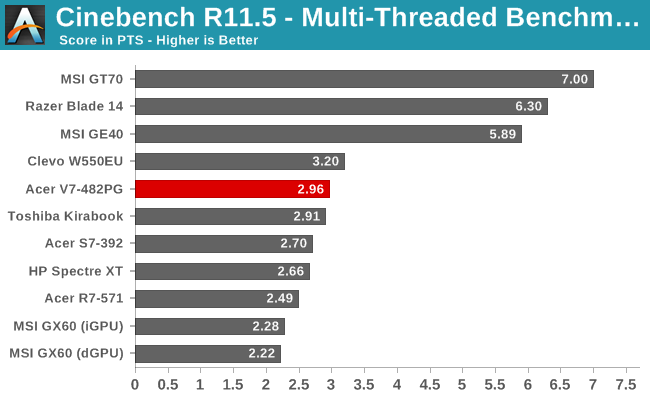
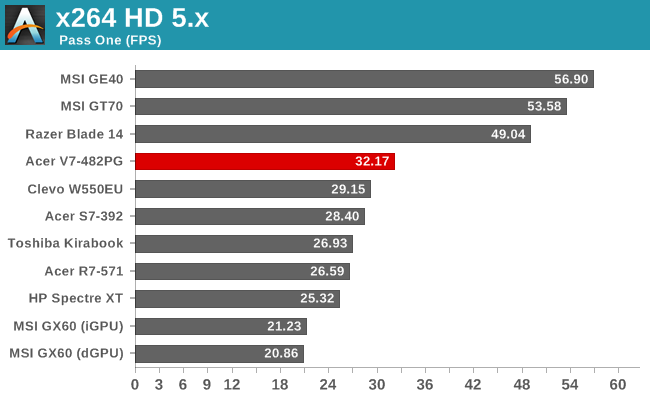

Starting as usual with PCMark 7, obviously the MSI GX60 is seriously penalized by not having a solid state drive. The rest of the systems all come together, with quad-core SSD systems at the top, followed by the dual-core SSD systems, and bringing up the rear we have hybrid SSD + HDD laptops like the Aspire V7. Personally, I find that hybrid storage feels a little closer to pure HDD than it does pure SSD, and benchmarks like PCMark 7 tend to paint a rosier picture than reality. Still, hybrid storage is far better than not having any solid state storage at all. For general use, the fact is that just about any modern system is more than fast enough – and other than a few specific use cases, a solid state drive doesn’t make your system two or three times faster, but it’s still definitely something I want to have in any modern system.
Our next set of performance benchmarks put more of the strain on the CPU, and here we see something that most of us already expected: Haswell isn’t substantially faster than Ivy Bridge. It seems like cooling and thermal throttling (or in other words, bios and firmware optimizations) can have a larger impact on performance than the choice of CPU. For example, the Toshiba KIRAbook and HP Spectre XT have virtually the same Core i7 Ivy Bridge CPU, but the Spectre XT ends up being substantially slower. In terms of where Haswell sits, the i7-4500U comes out ahead of all of the Core i7 ULV Ivy Bridge CPUs, but the difference ranges from a negligible 2-3% in Cinebench to a slightly more noteworthy 8-20% in x264 HD. How much of the difference in x264 is from IPC improvements and how much of it is just a question of BIOS/firmware differences is difficult to say – keep in mind that the Acer S7-392 has the same CPU, so firmware is probably the bigger factor.
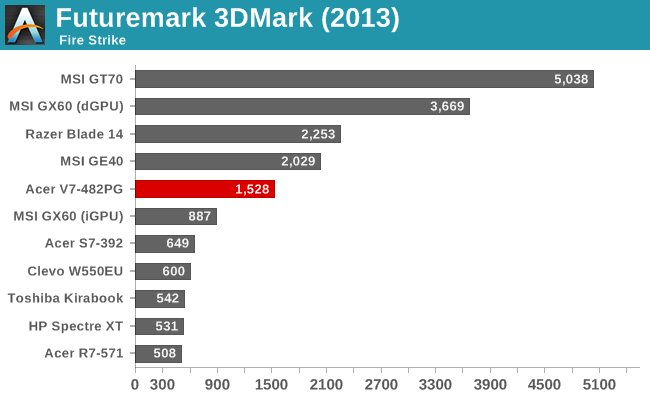
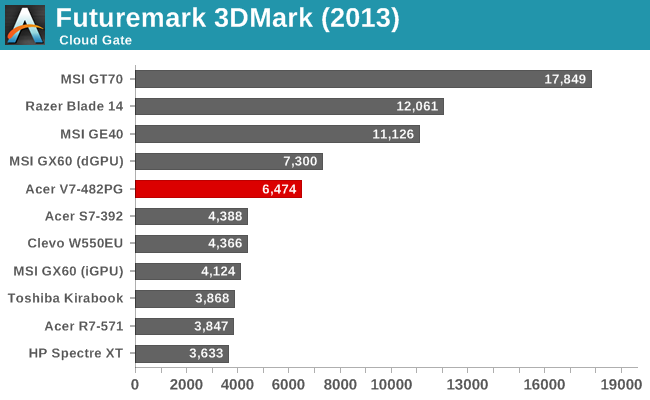
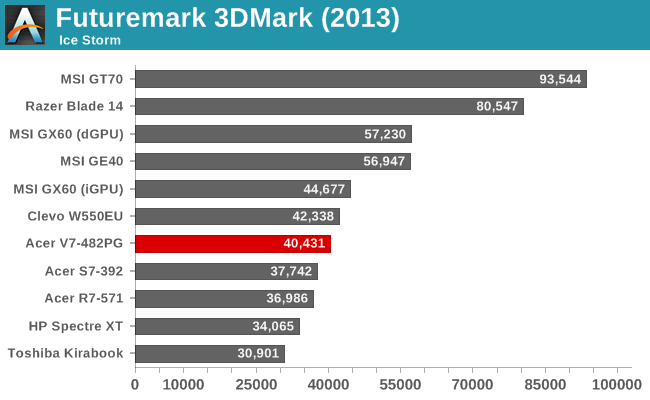
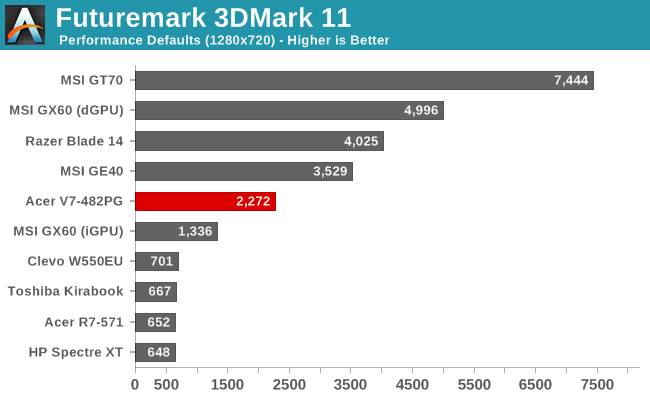
In terms of graphics performance, using 3DMark as our baseline estimate, there’s clearly a pecking order established: high-end GTX and HD 7900 GPUs, moderate GTX 760 GPUs, the GT 750M used in the V7, AMD’s Richland/Trinity iGPU, and then all of the Intel integrated graphics solutions. I’m still surprised that the GT2 implementations of Haswell haven’t really improved over the GT2 Ivy Bridge iGPU, but variations in clock speed certainly play a role. We should also be getting our first Crystalwell (Haswell GT3e) laptop in the next week, which of course will improve performance quite a bit but at a pretty hefty price. Depending on how much OEMs have to pay NVIDIA for something like the GT 750M, and considering the lack of GT3e on dual-core parts, I suspect we might end up waiting for Broadwell for a truly compelling mainstream iGPU from Intel.
And with that said, let’s move on to gaming benchmarks.










62 Comments
View All Comments
JarredWalton - Saturday, August 24, 2013 - link
Build quality is an unknown, as is battery life and some other factors, but the bigger issue is that you just can't get it yet, at least in the US. I need to ping Gigabyte and see what's up, as the only place I can find it in the US says, "This product is not available and cannot be purchased. It has been discontinued by the manufacturer or vendor." But it might simply be in the pre-release phase.GrammarNietzsche - Saturday, August 24, 2013 - link
The "major flaw" with the P34G seems to be its TN panel. source: http://www.expertreviews.co.uk/laptops/1300168/gig...You can also see the color shift on YouTube videos of the P34G.
davejake - Saturday, August 24, 2013 - link
The Gigabyte specs page claims it to be 1080p AHVA (~IPS)http://www.gigabyte.com/products/product-page.aspx...
This might be another obnoxious case of the various country models being different.
Also, thanks Jarred for the response. The "Gigabyte NB" facebook page keeps talking about early september availability for the p34g-- later for the the p35k-- but I'm trying to not hold my breath.
Samunosuke - Saturday, August 24, 2013 - link
Been looking forward to this review ever since you mentioned it was coming, in your R7 review. I believe this particular SKU is seriously overpriced. The model available on the US ncix website comes with an i5-4200U, GT 750m 4GB,same 1080p IPS touchscreen and 500GB + 24GB storage for $899. To me this is a far better value proposition than the $1300 model. The i5 might be a bottleneck in some games but its not going to be too different from the i7.Comparing this to the Asus N550 and I feel that the N550JV-DB72T is a far better deal with an i7-4700HQ, same GT 750m (2GB), 1080p IPS touchscreen,all aluminum body, max 16GB RAM and 3 USB 3.0 ports. Although the Acer has an msata slot for ssd's, the Asus has an optical drive where the mechanical drive can be put while a 2.5" ssd occupies the main HDD slot. Weight and thickness favour the Acer but I'm willing to accept that. The Acer is $1066 for the touchscreen version and $969 for the matte non touch. Absolute no brainer.
JarredWalton - Saturday, August 24, 2013 - link
The ASUS N550 does weigh about 1.5 pounds more, let's not forget that, and it looks like the same basic design as the N56JV, which was good but still rather bulky, with more plastic in the chassis. If you're after something with higher performance than the V7, there are many options out there; if you want what is basically a gaming Ultrabook that can handle any moderate task you might throw at it, I think the V7-482PG strikes a nice balance. I would like to have the option for a 1080p matte non-touch if it could save $150, but sadly there isn't one.Funny enough, the NCIX version of the V7 is apparently a Canadian model (http://store.acer.com/store/acerna/en_CA/pd/ThemeI... This is one of the frustrating things with Acer, ASUS, and a lot of other OEMs: they have good SKUs that are only released in specific markets, and often I can't figure out why. I've never tried ordering from NCIX before, but for $899 (though it's backordered), the V7-482PG-6662 is basically giving you a slower CPU, smaller HDD and less RAM for $400 less. Of course, that's a "street price" and I suspect the 9884 street prices might end up in the $1100-$1200 range, making it a more reasonable upgrade.
GrammarNietzsche - Saturday, August 24, 2013 - link
The 9884 is available on the US NCIX site as well. I couldn't link it in this comment, so you'll have to remove the (dot)http://us.ncix(dot)com/products/?sku=83180&vpn...
JBaich - Saturday, August 24, 2013 - link
Congrats to Acer for reversing course on the "race to the bottom". RTTBSadly, it might be another 10 years for me before the name Acer doesn't resonate with garbage. They will, and should, suffer for a build-em-and-sell-em-cheap strategy. I'm not convinced.
Anonymous1a - Saturday, August 24, 2013 - link
I was wondering, given that the processor, despite being an i7, is still a ULT processor, and not even a quad-core, will this not be a limiting factor to the graphics card and will this laptop be able to render graphically challenging games?JarredWalton - Saturday, August 24, 2013 - link
The majority of games still don't really need more than one or two CPU cores, and with Turbo Boost you're still able to hit 2.7-3.0GHz on the i7-4500U. With a faster GPU it would be more of a bottleneck, but the GT 750M is clearly tapped out in most titles already, at least at our Mainstream settings. (You'll notice that overclocking the GPU RAM didn't help on the Value settings, but that could be more the GPU core not needing more RAM than a CPU bottleneck; I'd have to investigate more to say for certain.) I think a GTX 765M would probably be where we see the shift to being CPU bound with a ULT processor, but even then you can usually get >40FPS from the CPU if the GPU can manage, so you can turn up details to compensate if you had a faster GPU.This is where the MSI GX60 runs into problems with some games, as single-threaded performance of the A10 APUs is still significantly slower than even the ULV/ULT parts. It's pretty sad that an Ultrabook with a much slower GPU can outperform it in several of the games, even at Mainstream detail.
just2btecky - Saturday, August 24, 2013 - link
Acer Aspire V7-482PG-9884 has a funky name I'll never remember. I aspire:) for a name that's really cute.